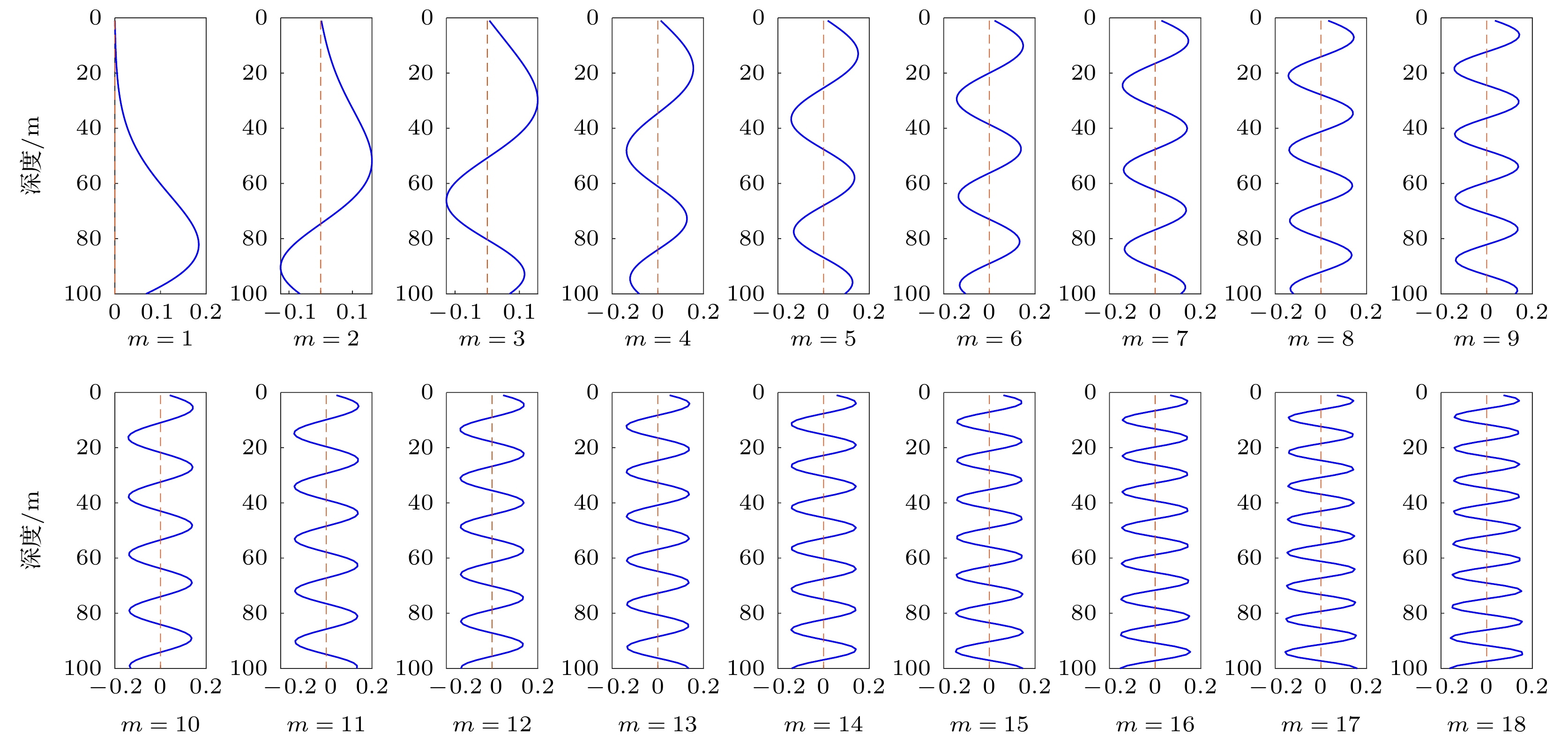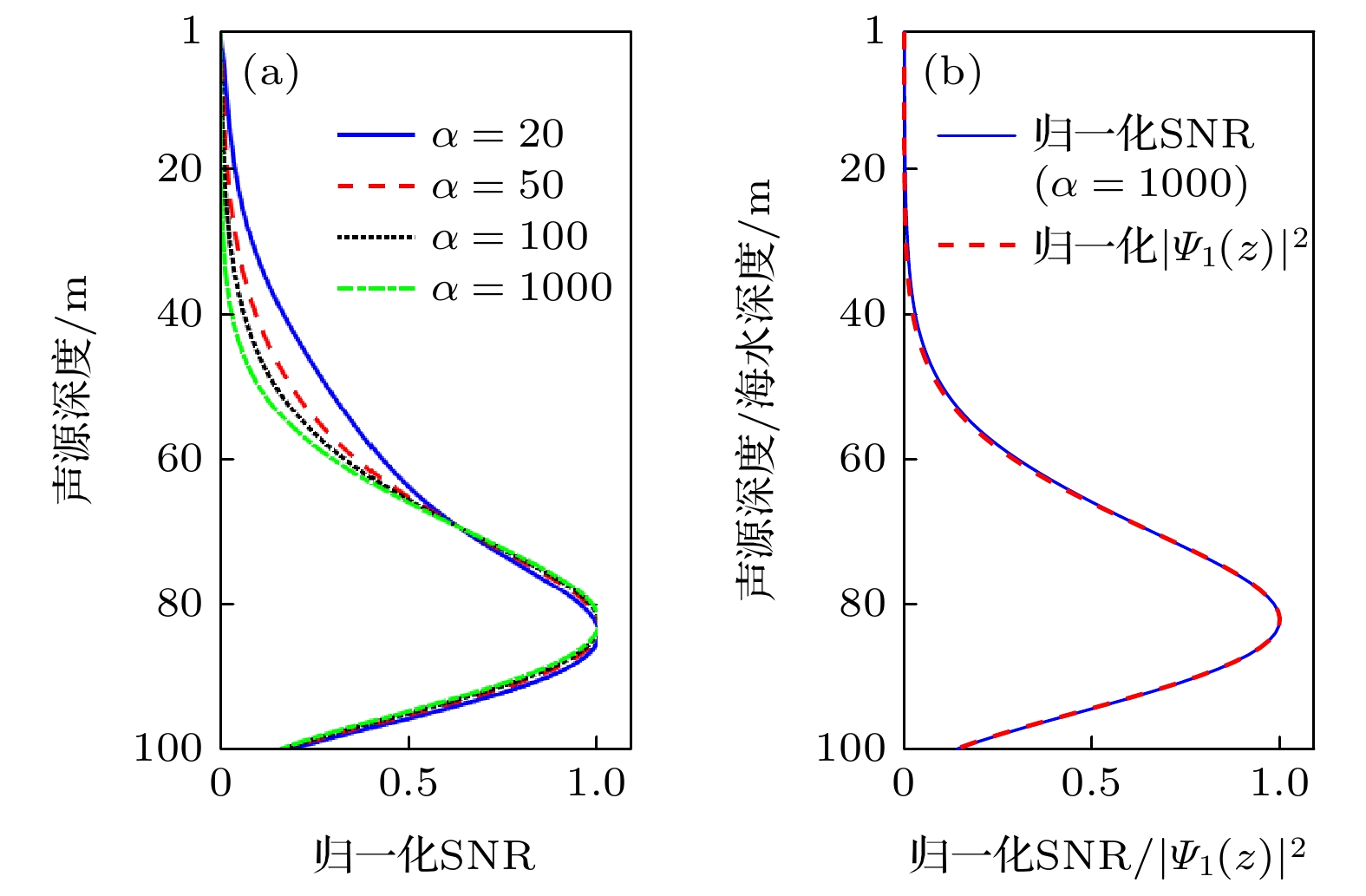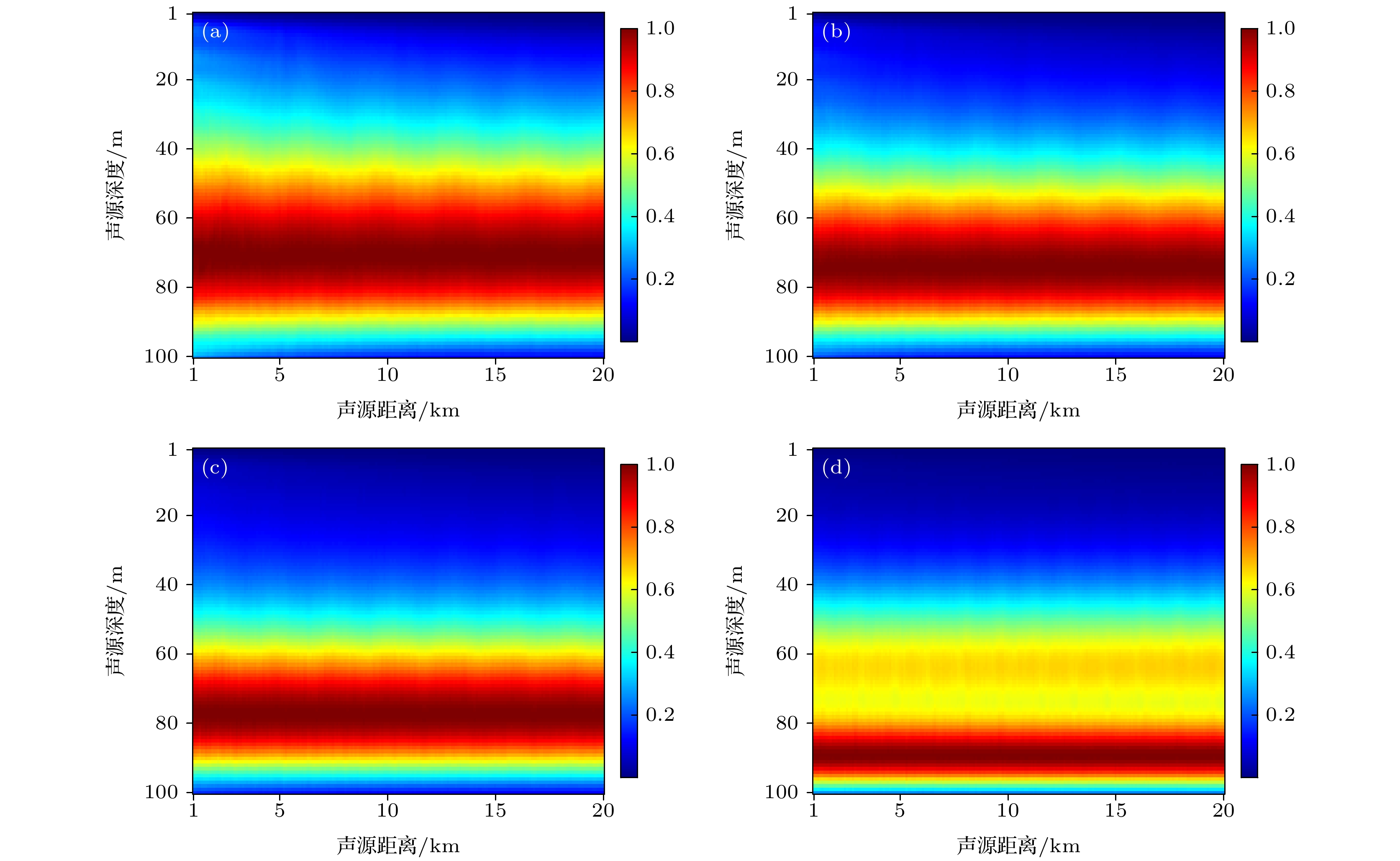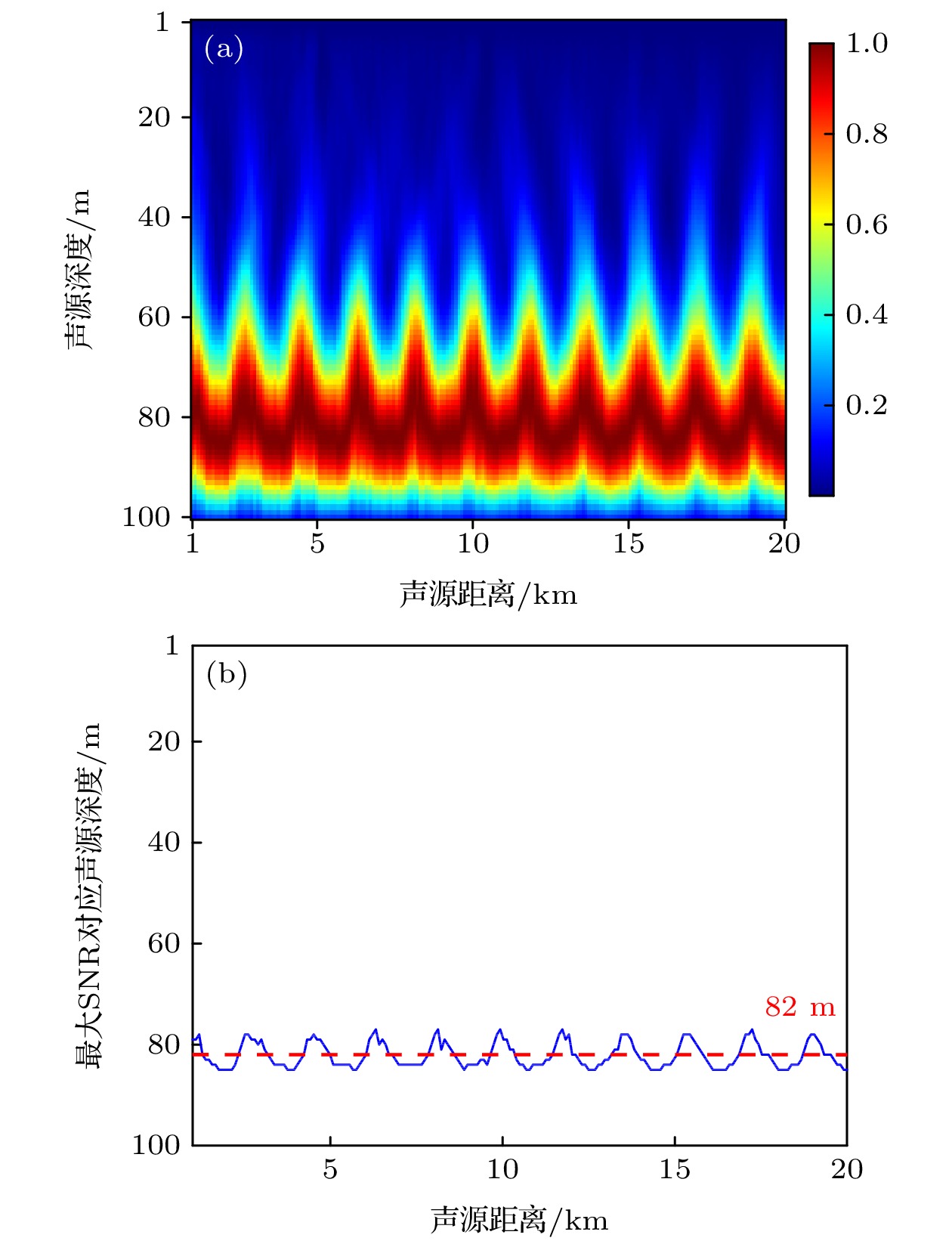-
风成噪声是海洋中最广泛存在的环境噪声、是被动声纳处理性能的重要影响因素.它具有一个典型的物理性质是很大程度上只对应中高阶模态. 阵列信噪比计入了阵列采样辐射声强、背景噪声功率和阵处理增益, 是决定声纳阵列处理性能的关键物理量. 本文研究了受风成噪声模态结构影响, 典型夏季浅海环境中垂直阵阵列信噪比随声源深度的变化关系. 在简正波模深函数采样完整的假设条件下, 理论证明了阵列信噪比随声源深度的变化可近似为低阶模态幅度强度(模深函数模值的平方)随深度变化的线性叠加, 且模态阶数越低, 贡献越大; 并且, 在强风成噪声背景、显著负梯度环境下该变化规律可由1阶模态幅度强度随深度的变化近似独立表征. 以上结果表明, 在同一声源距离条件下, 声源置于水体下半部分时的阵列信噪比比置于海面附近更大, 并且在位于1阶模态峰值点所在深度附近时达到最大. 典型负声速梯度浅海环境中的仿真实验结果对理论分析进行了验证, 并表明在一定条件下阵列信噪比随声源深度的变化与声源距离近似无关.Wind-generated noise is ubiquitous in ocean environments and highly influences the passive sonar performance. Since it originates from sources near the ocean surface, one of its physical features is that it largely represents only the intermediate- and high-order modes. The array-level signal-to-noise ratio (SNR), which includes the array-sampled sound intensity, background noise power, and array gain, is an essential quantity determining the sonar array performance. What is investigated in this work is how the array-level SNR of the vertical line array (VLA) varies with the source depth in downward-refracting shallow water, contributed by the modal structure of the surface noise. On the assumption that the modes are well sampled, it is theoretically demonstrated that the SNR varying with the source depth can be approximated as a linear combination of the lower-order mode-amplitude intensities varying with the water depth. Particularly, when the surface noise especially dominates and the water channel is highly downward refractive, this variation can be represented nearly only by the 1st-order mode-amplitude intensity varying with depth. The structure is meaningful in practice. It suggests the SNR will be inherently larger when the source is submerged than it is near the ocean surface, and will be maximized at a source depth slightly below the 1st-order mode peak across different source ranges. The above assertions are demonstrated in a typical downward-refracting shallow-water channel; the effects from the dominant degree of the surface noise, sound speed gradient in water column, and array aperture are investigated numerically. The obtained results are shown below. 1) Under certain circumstances, the variation of SNR with source depth is nearly irrelevant to the source range. 2) When the surface noise is more significant, the largest SNR in a certain source range will be more significantly larger than the SNR for the source near the surface, the corresponding source depth will be closer to that presenting the 1st-order mode’s peak, and the variation of SNR with source depth is increasingly irrelevant to the source range. 3) A stronger downward-refracting sound speed also enhances this SNR superiority and irrelevance to the source range, but causes the source depth presenting the largest SNR to be more deviated from the 1st-order mode’s peak. 4) Although the structure is unraveled on the assumption that the VLA spans the full water column, it can be seen when the VLA does not but covers the low-order modes' main part; when the array aperture is insufficiently large it will become approximately periodic in the source range, with the source depth presenting the largest SNR fluctuating lightly and nearly periodically around the 1st-order mode peak.
-
Keywords:
- surface noise /
- array-level signal-to-noise ratio /
- source depth /
- downward-refracting channel /
- source-range irrelevance
[1] Urick R J 1984 Ambient Noise in the Sea (Washington: Undersea Warfare Technology Office) pp2–30
[2] Hamson R M 1985 J. Acoust. Soc. Am. 78 1702
 Google Scholar
Google Scholar
[3] Zakarauskas P 1986 Canadian Acoust. 14 3
[4] Dahl P, Miller J, Cato D, Andrew R 2007 Acoust. Today 3 23
 Google Scholar
Google Scholar
[5] Jensen F B, Kuperman W A, Porter M B, Schmidt H 2000 Computational Ocean Acoustics (New York. USA: Springer-Verlag) chap 9, pp338–340
[6] Cron B F, Sherman C H 1962 J. Acoust. Soc. Am. 34 1732
 Google Scholar
Google Scholar
[7] Kuperman W A, Ingenito F 1980 J. Acoust. Soc. Am. 67 1988
 Google Scholar
Google Scholar
[8] Liggett W S, Jacobson M J 1965 J. Acoust. Soc. Am. 38 303
 Google Scholar
Google Scholar
[9] Yang T C, Kwang Y 1997 J. Acoust. Soc. Am. 101 2541
 Google Scholar
Google Scholar
[10] 周建波, 朴胜春, 刘亚琴, 祝捍皓 2017 物理学报 66 014301
 Google Scholar
Google Scholar
Zhou J B, Piao S C, Liu Y Q, Zhu H H 2017 Acta Phys. Sin. 66 014301
 Google Scholar
Google Scholar
[11] Jiang D, Li Z, Qin J, Peng Z, Shao H 2017 Sci. China Phys. Mech. 60 124321
 Google Scholar
Google Scholar
[12] 蒋光禹, 孙超, 谢磊, 刘雄厚 2019 物理学报 68 024302
 Google Scholar
Google Scholar
Jiang G Y, Sun C, Xie L, Liu X H 2019 Acta Phys. Sin. 68 024302
 Google Scholar
Google Scholar
[13] Kay S 1993 Fundamentals of Statistical Signal Processing Volume II: Detection Theory (New Jersey: Prentice Hall) pp197–200, 478–479
[14] Kong D Z, Sun C, Li M Y, Xie L 2021 Defence Technology 17 1414
 Google Scholar
Google Scholar
[15] Li M Y, Sun C, Zhao H, Willett P 2022 IEEE J. Ocean. Eng. 47 201
 Google Scholar
Google Scholar
[16] Baggeroer A B, Kuperman W A, Schmidt H 1987 J. Acoust. Soc. Am. 83 571
 Google Scholar
Google Scholar
[17] Buck J R, Preisig J C, Wage K E 1998 J. Acoust. Soc. Am. 103 1813
 Google Scholar
Google Scholar
[18] 向龙凤, 孙超, 李明杨 2015 声学学报 40 779
 Google Scholar
Google Scholar
Xiang L F, Sun C, Li M Y 2015 Acta Acustica 40 779
 Google Scholar
Google Scholar
[19] Wang N, Liu J Z 2002 Chin. Phys. B 11 456
 Google Scholar
Google Scholar
[20] Kim K, Woojae S, Keunhwa L 2010 IEEE J. Ocean. Eng. 35 120
 Google Scholar
Google Scholar
[21] Van Trees H L 2002 Optimum Array Processing: Part IV of Detection, Estimation, and Modulation Theory (New York: John Wiley & Sons) pp449–450
[22] Neilsen T B, Westwood E K 2002 J. Acoust. Soc. Am. 111 748
 Google Scholar
Google Scholar
[23] Porter M B 1991 The KRAKEN Normal Mode Program (La Spezia: SCALANT Undersea Research Center)
[24] [25] Wenz G M 1962 J. Acoust. Soc. Am. 34 1936
 Google Scholar
Google Scholar
[26] Yang T C 1987 J. Acoust. Soc. Am. 82 1736
 Google Scholar
Google Scholar
[27] 李明杨, 孙超, 邵炫 2014 物理学报 63 204302
 Google Scholar
Google Scholar
Li M Y, Sun C, Shao X 2014 Acta Phys. Sin. 63 204302
 Google Scholar
Google Scholar
-
图 3 垂直阵覆盖全水深时风成噪声协方差矩阵特征向量与模态采样的对应关系 (a)归一化特征值; (b) 特征向量与模态采样的相关系数
Fig. 3. Corresponding relation analysis between eigenvectors of the surface noise covariance matrix and sampled modes for the vertical line array spanning the full water column: (a) Normalized eigenvalues; (b) correlations between eigenvectors and sampled modes.
图 6 声源距离10 km上归一化SNR随声源深度的变化结果 (a)不同风成噪声强度; (b)
$\alpha = 1000$ 时SNR随声源深度与1阶模态幅度强度随深度变化对比Fig. 6. Normalized SNR versus source depths at
${r_{\rm{s}}} = 10\;{\rm{km}}$ : (a) Different α; (b) comparison of source depths and the 1 st-order mode-amplitude intensity varying with water depths for$\alpha = 1000$ .图 11 垂直阵覆盖50—100 m时(a)不同声源距离上SNR随声源深度的变化结果和(b) 最大SNR对应的声源深度(红色虚线为1阶模态峰值点所在深度)
Fig. 11. For the vertical line spanning from 50 to 100 m in depth: (a) Normalized SNR versus source depths; (b) the source depth presenting the largest SNR at different source ranges(The red dashed line is the depth of the peak point of the first-order mode).
图 12 垂直阵覆盖50—100 m时影响SNR的模态采样分析 (a) 模态采样与特征向量相关系数); (b) 不同特征向量对SNR的归一化权值, 通过第11个特征向量的归一化
Fig. 12. Analysis of mode’s contribution to the SNR for the vertical line array spanning from 50 to 100 m in depth: (a) The correlation between sampled modes and eigenvectors; (b) the weights of different eigenvectors to the SNR, normalized by that of the 11 th eigenvector.
-
[1] Urick R J 1984 Ambient Noise in the Sea (Washington: Undersea Warfare Technology Office) pp2–30
[2] Hamson R M 1985 J. Acoust. Soc. Am. 78 1702
 Google Scholar
Google Scholar
[3] Zakarauskas P 1986 Canadian Acoust. 14 3
[4] Dahl P, Miller J, Cato D, Andrew R 2007 Acoust. Today 3 23
 Google Scholar
Google Scholar
[5] Jensen F B, Kuperman W A, Porter M B, Schmidt H 2000 Computational Ocean Acoustics (New York. USA: Springer-Verlag) chap 9, pp338–340
[6] Cron B F, Sherman C H 1962 J. Acoust. Soc. Am. 34 1732
 Google Scholar
Google Scholar
[7] Kuperman W A, Ingenito F 1980 J. Acoust. Soc. Am. 67 1988
 Google Scholar
Google Scholar
[8] Liggett W S, Jacobson M J 1965 J. Acoust. Soc. Am. 38 303
 Google Scholar
Google Scholar
[9] Yang T C, Kwang Y 1997 J. Acoust. Soc. Am. 101 2541
 Google Scholar
Google Scholar
[10] 周建波, 朴胜春, 刘亚琴, 祝捍皓 2017 物理学报 66 014301
 Google Scholar
Google Scholar
Zhou J B, Piao S C, Liu Y Q, Zhu H H 2017 Acta Phys. Sin. 66 014301
 Google Scholar
Google Scholar
[11] Jiang D, Li Z, Qin J, Peng Z, Shao H 2017 Sci. China Phys. Mech. 60 124321
 Google Scholar
Google Scholar
[12] 蒋光禹, 孙超, 谢磊, 刘雄厚 2019 物理学报 68 024302
 Google Scholar
Google Scholar
Jiang G Y, Sun C, Xie L, Liu X H 2019 Acta Phys. Sin. 68 024302
 Google Scholar
Google Scholar
[13] Kay S 1993 Fundamentals of Statistical Signal Processing Volume II: Detection Theory (New Jersey: Prentice Hall) pp197–200, 478–479
[14] Kong D Z, Sun C, Li M Y, Xie L 2021 Defence Technology 17 1414
 Google Scholar
Google Scholar
[15] Li M Y, Sun C, Zhao H, Willett P 2022 IEEE J. Ocean. Eng. 47 201
 Google Scholar
Google Scholar
[16] Baggeroer A B, Kuperman W A, Schmidt H 1987 J. Acoust. Soc. Am. 83 571
 Google Scholar
Google Scholar
[17] Buck J R, Preisig J C, Wage K E 1998 J. Acoust. Soc. Am. 103 1813
 Google Scholar
Google Scholar
[18] 向龙凤, 孙超, 李明杨 2015 声学学报 40 779
 Google Scholar
Google Scholar
Xiang L F, Sun C, Li M Y 2015 Acta Acustica 40 779
 Google Scholar
Google Scholar
[19] Wang N, Liu J Z 2002 Chin. Phys. B 11 456
 Google Scholar
Google Scholar
[20] Kim K, Woojae S, Keunhwa L 2010 IEEE J. Ocean. Eng. 35 120
 Google Scholar
Google Scholar
[21] Van Trees H L 2002 Optimum Array Processing: Part IV of Detection, Estimation, and Modulation Theory (New York: John Wiley & Sons) pp449–450
[22] Neilsen T B, Westwood E K 2002 J. Acoust. Soc. Am. 111 748
 Google Scholar
Google Scholar
[23] Porter M B 1991 The KRAKEN Normal Mode Program (La Spezia: SCALANT Undersea Research Center)
[24] [25] Wenz G M 1962 J. Acoust. Soc. Am. 34 1936
 Google Scholar
Google Scholar
[26] Yang T C 1987 J. Acoust. Soc. Am. 82 1736
 Google Scholar
Google Scholar
[27] 李明杨, 孙超, 邵炫 2014 物理学报 63 204302
 Google Scholar
Google Scholar
Li M Y, Sun C, Shao X 2014 Acta Phys. Sin. 63 204302
 Google Scholar
Google Scholar
计量
- 文章访问数: 7059
- PDF下载量: 96
- 被引次数: 0













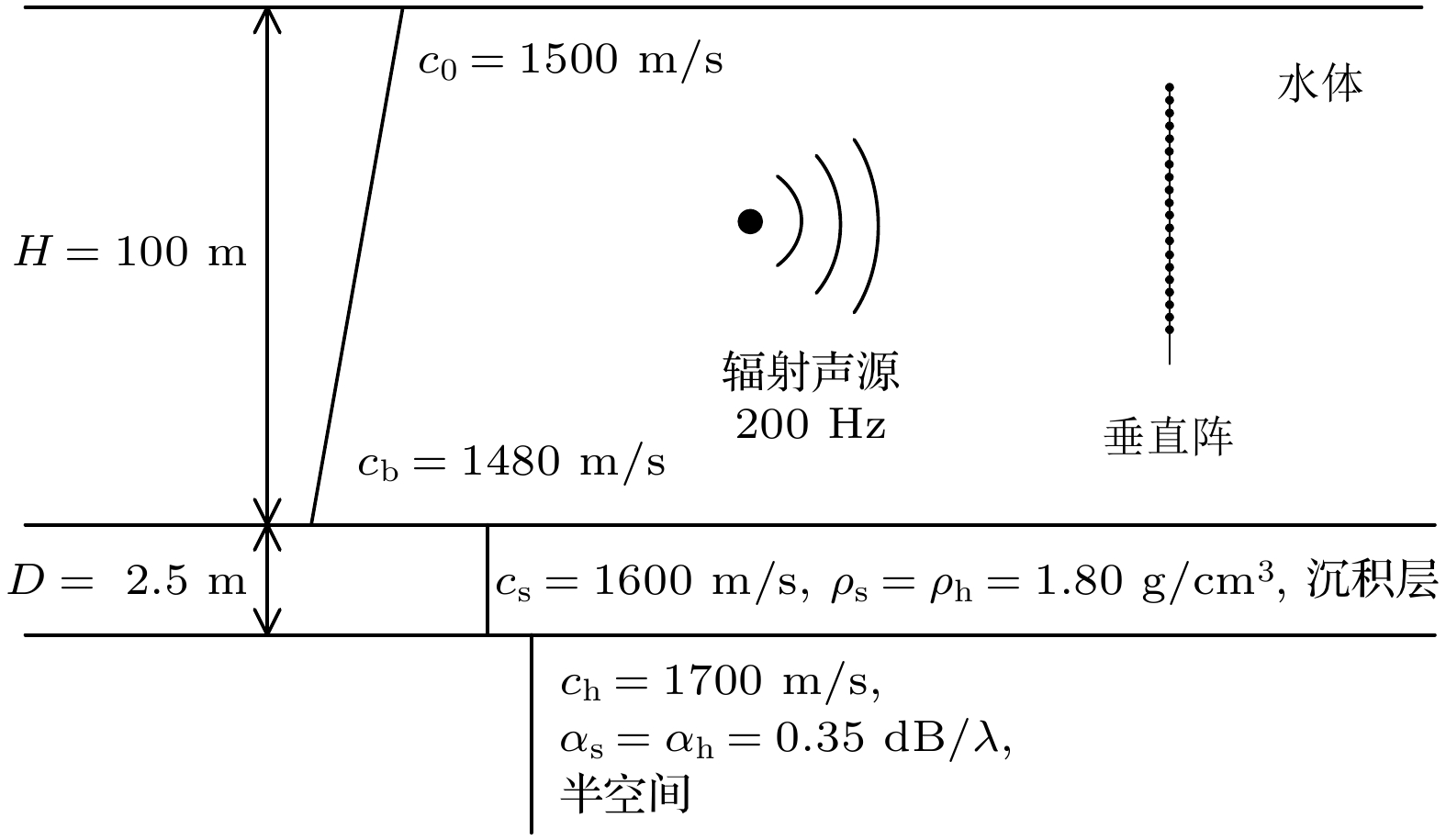
 下载:
下载:
